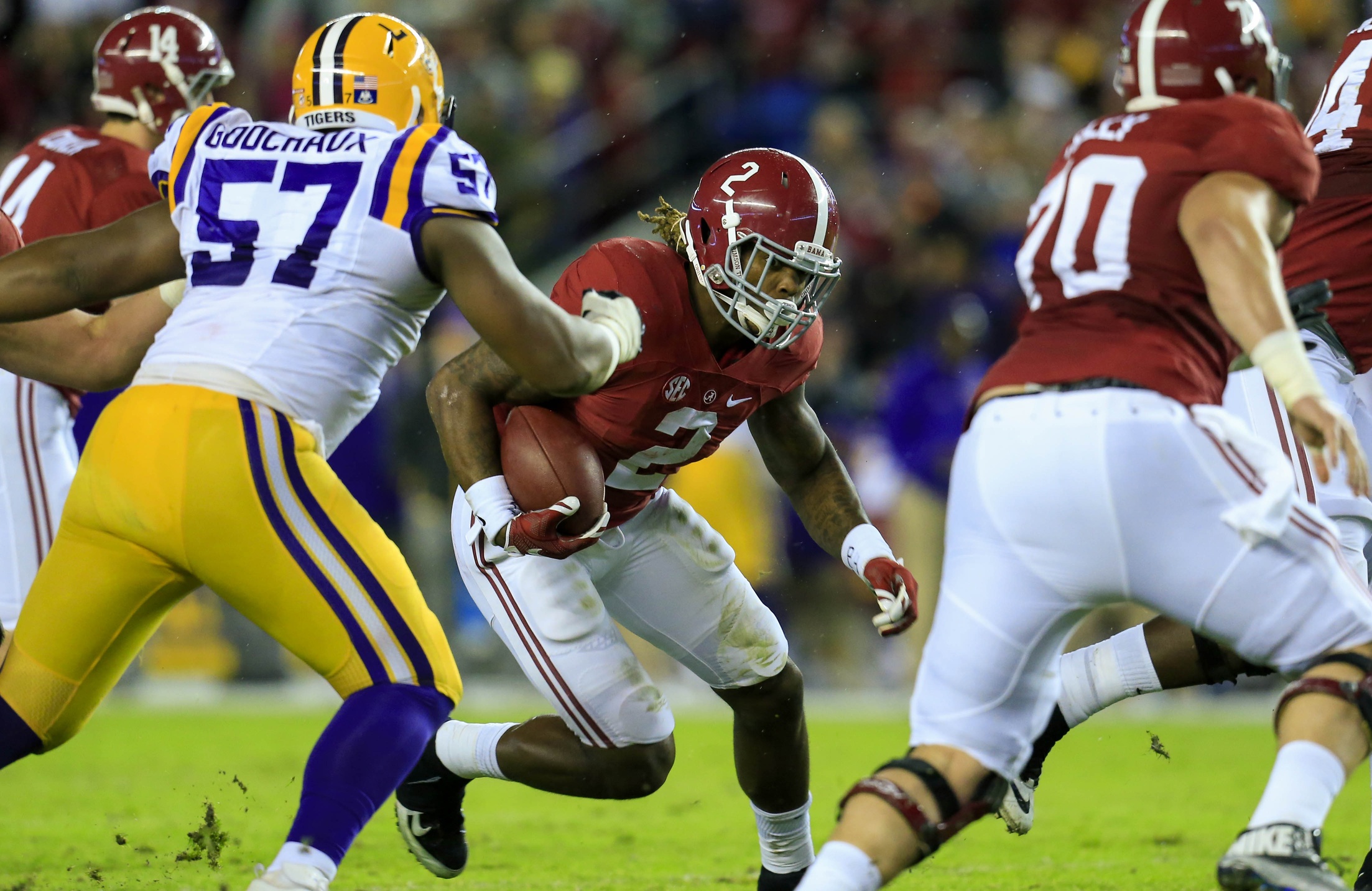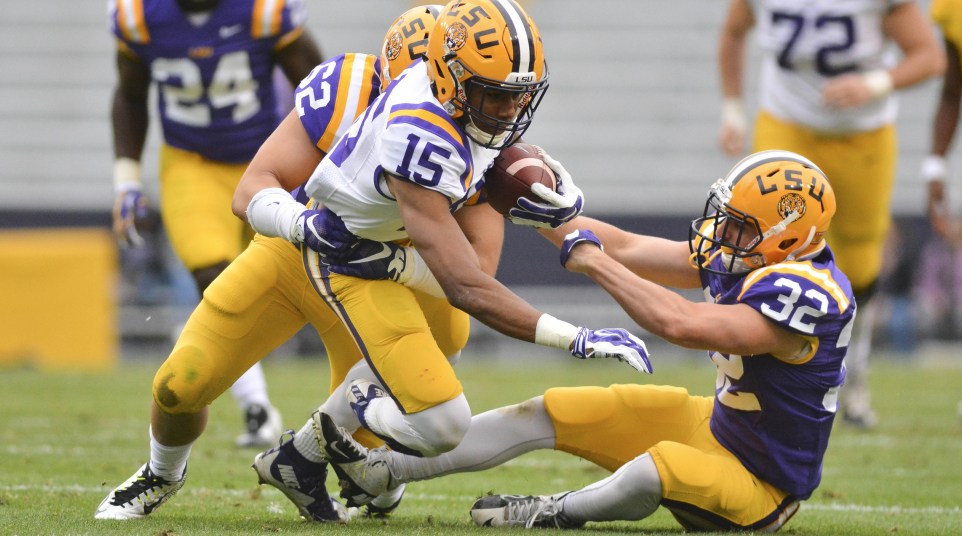For LSU defensive coordinator Dave Aranda, end of spring far from a break
BATON ROUGE, La. — After LSU’s spring game Saturday, the entire team gathered at the Tiger Stadium 50-yard line for an awards ceremony. Head coach Les Miles handed out merit trophies to, it seemed, about half the team.
It was the end of spring practice, but it felt like the end of a summer camp. Awards for everybody, then a lot of hugs and handshakes. It was, after all, time to put the period on the spring practice sentence and move on.
But not Dave Aranda.
The first-year defensive coordinator broke the final huddle and started to head toward the Tiger Stadium exit with a look of deep thought on his face. When he was intercepted by reporters eager for the rare chance to interview an LSU coordinator (they are off limits during most of the regular season), he seemed to be in a contemplative mood.
After all, his project — namely, turning an LSU defense that’s been a 4-3 for years into a 3-4 team — is barely getting started. Spring practice may be over, but his task is just warming up.
“Defensively we put in a nice base,” is the way head coach Les Miles put it, adding later that, “We have a nice platform and foundation that should allow us to make change.”
What exactly will those changes be? That’s a question that, as LSU broke for summer, is only starting to be answered. Aranda’s job is akin to a chemist looking for the right formula of scheme and players to create a defense that will be effective against the teams on LSU’s schedule.
At his previous stops as a a defensive coordinator at Wisconsin, Utah State and Hawaii, the California native’s approach has been a little different each time. So spring at a new school isn’t all about teaching his way; it’s also about learning from his new personnel so his way can match their talents.
That doesn’t make for installing an entire defense in 15 practices. The Tigers, in fact, are far from that.
“We’ve got about three (defensive) calls in,” Aranda said Saturday, a small number for what is a complex and multiple defense. “So we have a lot of work to do this summer and we look forward to it.”
After all, even as the Tigers learn the plays, they are also still tinkering with personnel moves and they may still be tinkering in August and even September when the games are for real.
“Any time you’re new and you’re dealing with coaches you haven’t coached with before and you’re dealing with players you haven’t been around before and new practice schedules and new meeting times and all sorts of things, there’s always things to work through,” Aranda said.
LSU’s defensive players know that well. Change has become a new custom with LSU defense.
Aranda will be the third defensive coordiantor in as many years. John Chavis left for the 2014 season for Texas A&M. Miles replaced him with Alabama assistant Kevin Steele, but he left after just one year to take the same job at Auburn last December.
Chavis was a 4-3 guy and, though Steele had a 3-4 background, what LSU ran last season was mostly a tweaked version of the 4-3. So changing that culture was going to require commitment, which Aranda has, and a lot of tinkering.
That was evidence of the tinkering in the spring game. For example, midway through the spring, Aranda switched nose guard Christian LaCouture, a two-year starter as a 4-3 defensive tackle, to defensive end while Davon Godchaux, the other starting defensive tackle last year, moved to nose guard.
It seemed like a move counter to conventional wisdom. LaCouture, at 307 pounds, outweighs Godchaux by a good 20 pounds. And isn’t the 3-4 nose guard supposed to be a space-eating giant who demands double teams from the offense through his sheer force of size?
“You go with what you got,” Aranda said. “If you have a player like Godchaux, it allows you to slant and angle. If you do play base and an o-lineman is on his heels because he’s concerned about the movement, Godchaux can get back on him. So either way. When I was at Wisconsin my first year, we had 300-pounders across the (defensive line) board, so the nose was 335 pounds. So we didn’t slant and angle as much with them, it was more just knock back (the offensive line).
“I think Godchaux has the ability to knock back, but also to slant and angle, so it’s a mix. Either way works, but you have to play to your strengths.”
And it doesn’t take a genius to figure out that LSU’s strength, as always, is its across-the-board athleticism. So it’s easy to see a version of the 3-4 that emphasizes athletic players coming down the pike.

For Godchaux, it’s a chance to make plays at a position where the stereotype is that it’s a spot where one simply absorbs blocks for others to make plays.
“I use my quickness, get some penetration, get some pass rush out there,” said Godchaux, who said he “loves” the move to nose guard. “It’s pretty good. It’s only going to help me in the future.”
Will LSU start recruiting the 350-pound space eaters to play the position? Perhaps, but for now, Aranda seems to have found his defensive line formula for this team.
Don’t expect that to be the last position move as LSU tries to fit old pieces into a new puzzle.
Dwayne Thomas seemed to find a home at safety, consistently providing pressure with well-timed blitzes. As LSU gets players back — safety Rickey Jefferson and corners Tre’Davious White and Donte Jackson were all banged up or out for all or parts of spring — expect more experimentation there.
And the linebacker corps has shifted around. Duke Riley started the spring at one of the new outside linebacker spots but is now starting inside next to Kendell Beckwith. Former defensive ends, most notably speed rusher Arden Key, have moved to outside linebacker. So has converted safety Corey Thompson.
So many players are playing new positions, it’s no wonder there are only three calls the group has learned.
“In the beginning, you’re open to try new things,” Aranda said. “Is Godchaux best inside? Is (defensive end) Lewis Neal best outside? Is (Tashawn) Bower (a former defensive end) best as an outside linebacker? It allows you to move people around and feel like it’s not a one (position) and done. Let’s figure this thing out and see who’s best.
“Spring was great for that and we are much further ahead because of that.”
At any spring practice, that kind of experimentation happens. Is a wide receiver not able to find playing time? Maybe that athletic third quarterback is a possibility at receiver. Perhaps you want to see if an athletic safety can cover at corner. These are things coaches are more hesitant to try at August camp, with a season opener just weeks away.

It happens all the time, everywhere. But at LSU this spring, the moves were fundamental to the building of the defense’s identity. It’s not a handful of marginal players trying to find a new niche. It’s established starters like Godchaux and LaCouture. It’s an up-and-coming defensive end like Key becoming a linebacker.
LSU’s defensive players seem to be adjusting just fine.
“It’s a new defense and we’ve accepted the challenge,” said Beckwith, a two-year starter who is the rare accomplished player to return for his senior season. “I think overall we’ve improved and worked to get better and better. We tried to learn the plays and grow as a defense and I think we did a good job of that.”
As the players learn from Aranda, the new coordinator has learned ways to use his personnel’s athleticism that hints at what the unit’s eventual identity will be.
“We don’t really pressure a lot of guys, five or six (rushers),” he said. “It’s always four-man rushes, so we’re trading jobs. Trading jobs in our three-deep and trading jobs in our man. So the base three deep and man are in. Now it’s just trading jobs.”
By trading jobs, Aranda means that if, for example, Thomas is to blitz from his safety spot, another player — maybe a linebacker, maybe another secondary player, has to replace Thomas in coverage. The fourth rusher can come from anywhere, which allows Aranda to stay with a base look while leaving the offense guessing at where a fourth rusher is going to come from. For that to work, players who to be able to do the job that is normally the job of another position.
At LSU, players like Riley, the high school track star at linebacker, or hard-hitting safety Jamal Adams, are versatile enough to pull it off.
Arden Key working out during #LSU practice. Some high expectations for the sophomore, who is now working at OLB. pic.twitter.com/u9yeWg0Dzs
— Shea Dixon (@Sheadixon) April 7, 2016
“The flexibility of guys to rush or drop, to do those jobs, that’s exciting that we have those guys,” he said. “How far do we go? That’s the question. Summertime is a good time to work on that.”
And with that, Aranda was off to start the summer, back to his lab where he’ll be mixing and matching his pieces. It’s a process he knows won’t be over soon. How many defensive calls will eventually come out of that lab?
“I don’t know,” he said. “Part of it is figuring out what we’re best at. I think there’s a better understanding of that now than there was before. But a lot of times, that goes all the way into the summer and it could be all the way to game one, game two, figuring out who is best at doing what.
“There were a lot of good things today. But we’re still learning each other, learning what we can do.”

